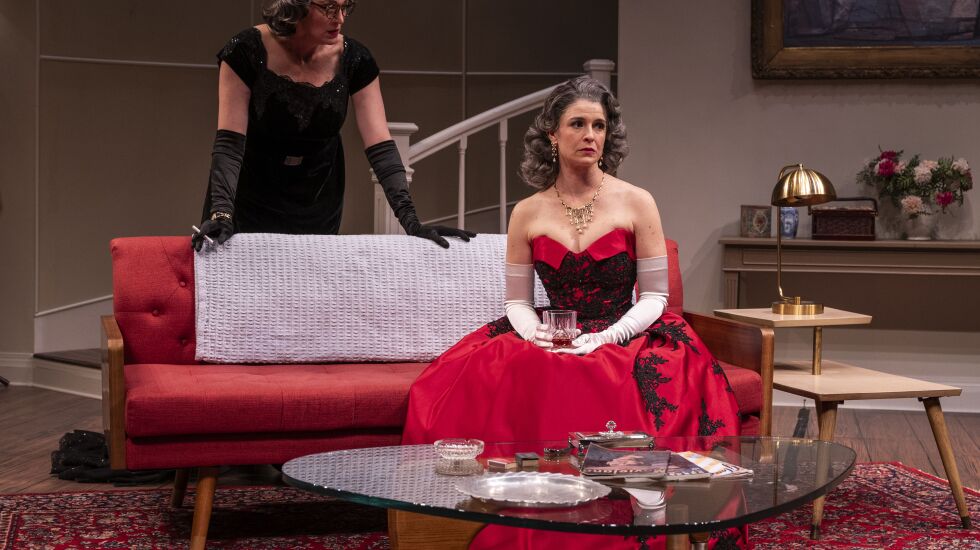
Decades before “Columbo” put the formula on prime time, playwright Frederick Knott’s “Dial M for Murder” put an ingenious new spin on the murder-mystery genre: The murderer in “Dial M” is revealed early. The suspense lies not in figuring out whodunnit, but in watching an extraordinarily proficient, often underestimated sleuth uncover the villain amid a stage filled with intriguing suspects and tangled motives. Running through Dec. 31 at Skokie’s Northlight Theatre, Jeffrey Hatcher’s 2021 adaptation of Knott’s 1952 “Dial M for Murder” isn’t entirely hair-raising. But it’s a satisfying thriller that breathes new life into a potentially musty script.
Director Georgette Verdin has her work cut out for her: “Dial M” unfolds entirely in a single room. It relies on frequent, lengthy swaths of exposition to do most of the plot’s heavy lifting. A wordy play in a largely static environment, “Dial M” requires that the audience lean in, not sit back.
Verdin and her ensemble make the effort worth it. “Dial M” calls up a noirish universe filled with shady corners and shadier characters as well as a heroine who both falls prey to their schemes and fights back against them.
“Dial M” is first and foremost a crackling murder mystery, just as it was when it premiered as a BBC radio play 71 years ago and when Alfred Hitchcock’s movie version dropped in 1954. Hatcher’s revisions give the drama layers of meaning and 21st century relevance that Knott probably never thought of. The hairpin-twisting drama revolves around Margot Wendice (Lucy Carapetyan), and her boa constrictor-smooth husband Tony (Ryan Hallahan). Tony plays the part of a loyal husband like a virtuoso, but his sinister, sociopathic core lurks just below the surface.
Margot is wealthy, and Tony wants that money without the hassle of the wife that comes with it. Early on, Tony hires a chap who goes by Lesgate (Felipe Carrasco) to dispatch Margot. The scheme — which hinges on the timing of a telephone call — goes sideways quickly. There’s a dead body, to be sure, but not the one Tony asked for. There’s also a wrongful conviction and a shattered love story, neither of which were part of Tony’s supposedly foolproof plan.
Tony has already embarked on a new life unencumbered by his wife, when Inspector Hubbard (Nick Sandys) arrives with questions and — ultimately — conclusions that Tony wants nothing to do with. As Hubbard ferrets out hidden truths about the botched murder, Margot’s friend and former romantic partner Maxine Hadley (Elizabeth Laidlaw) contends with a broken heart and no small amount of barely suppressed rage at the fate of her beloved.

The romantic subplot in Knott’s original and Hitchcock’s movie is traditionally hetero. By making it between Margot and Maxine, Thatcher underscores the horrendous strictures that came with living as closeted gay women in the 1950s. In Laidlaw’s set jaw and Carapetyan’s heart-breaking practicality, their plight is both tragic and a moving depiction of love that remains unswerving even under the worst possible circumstances.
“Dial M” is somewhat perfunctory until Hubbard steps on stage. Sandys’ deadpan queries and revelations are marvelously entertaining, his every interaction indicating a world of subtext. Even as he delivers a dramatic denouement that explains the true facts behind the murder, Sandys never falls into melodrama or stereotype. He’s the heart of the drama, his every word steeped in arid, borderline caustic humor.
It’s tough to say much about Margot without giving away spoilers, so suffice to say Carapetyan balances extreme vulnerability with the ferocity in a physically and emotionally intense performance that’ll have you biting your nails in suspense.
Ryan Hallahan’s Tony seems every inch the charmer, a facade that never breaks even when his craven brand of narcissism and greed becomes undeniable. And as his henchman Lesgate, Carrasco is suitably thuggish.
The production plays out on Mara Ishihara Zinky’s museum-worthy rendition of a mid-century modern living room that looks pulled from the pages of Better Homes and Gardens, circa 70 years ago.
“Dial M for Murder” sometimes lags amid the reams of dialogue. But fans of ingenious mysteries, nefarious bad guys and suave British sleuths of Holmesian powers of observation will find Northlight’s production acquits itself well as a solid entry to the genre.







